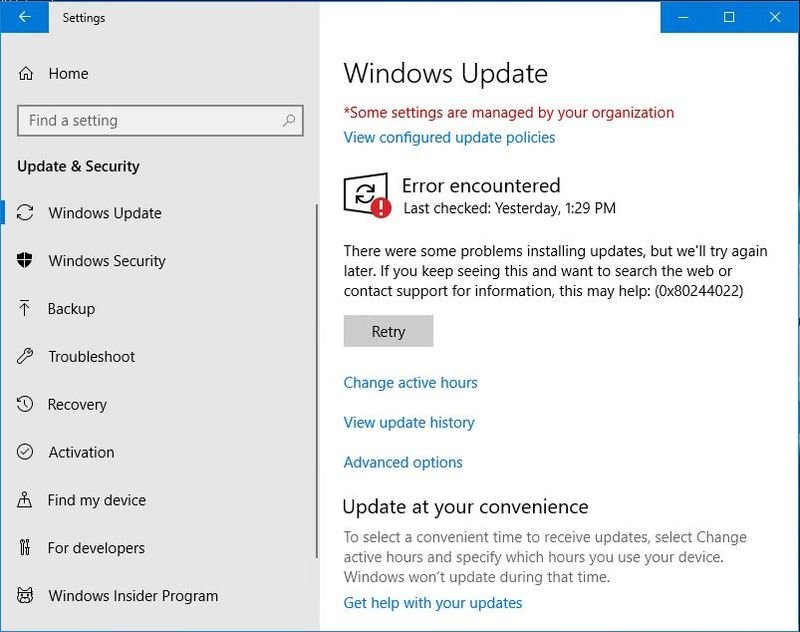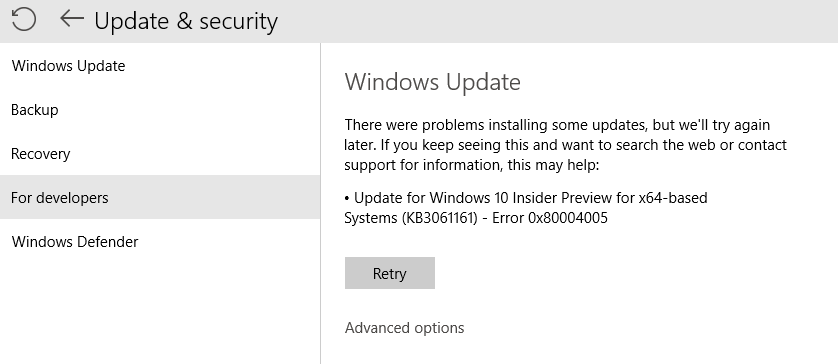Even though Microsoft is making the upgrade to Windows 10 an easy process, many users are experiencing a number of issues. Today we look at some of these issues and what you can do to fix them! How to fix Windows 10 Update errors in Windows 10. The following errors are addressed in this tutorial: Windows 10 update error Windows 10 update error - sol.
Fix Windows Update errors is a troubleshooting page on Microsoft's Support website that aims to help Windows users resolve update related errors.

This guided walk-through provides steps to fix problems when installing updates. Here are some commonly seen error codes: 0x80073712, 0x800705B4, 0x80004005, 0x8024402F, 0x80070002, 0x80070643, 0x80070003, 0x8024200B, 0x80070422, 0x80070020. These steps should help with all errors and not just the ones listed.
The support page covers Windows 7, Windows 8.1 and Windows 10 only. First thing you do is select one of the listed operating systems on the page.
What happens afterwards depends on that selection.
Fix Windows Update errors
Windows 10 users are asked to download the Windows Update Troubleshooter to their device and run it for instance, while Windows 7 users to run the built-in troubleshooter of the operating system instead before they are offered an updated -- but different -- update troubleshooter for the operating system.
This is not the only difference though. While you get fairly basic suggestions for Windows 7 -- try the troubleshooter, if that does not work, run a system recovery -- suggestions for Windows 10 include two additional steps.

The first asks you to find the most recent update for Windows 10 that is installed on the machine, run a search for it on Microsoft's Update site, and download and run the update again.
The second option, if that did not work either, is to run commands on the command line (with administrative privileges):
DISM.exe /Online /Cleanup-image /Restorehealth
sfc /scannow
DISM.exe is the Deployment Imaging and Servicing Management tool which you may use to correct Component Store corruption.
The second command checks core Windows files for corruption, and replaces them if possible with the correct version.
Latestwu.diagcab
The Windows Update troubleshooter for Windows 10 is an improved version of the troubleshooter for previous versions of Windows.

It checks Windows Update and the Background Intelligent Transfer Service (Bits), and also runs Windows Network diagnostics.
I suggest you click on advanced on the first screen that opens and disable the automatic repair option. This gives you full control over the troubleshooting process.
Windows Update Troubleshooter
The troubleshooter displays all repair options after a quick scan:
- Repair Windows Update Database corruption.
- Repair Windows update components.
- Fix Windows Firefox blocking connections to Windows Update on the PC.
- Contact a network or system administrator, or ISP, to fix Internet connectivity issues.
- Check whether default Windows Update data locations have changed.
- Fix improperly configured security settings, or missing settings.
- Check for missing or corrupt files.
- Fix service registration is missing or corrupt.
- Fix system date and time aren't correct.
As you can see, the tool checks for a couple of things and may fix most of them when you give the ok (or automatically if you have not changed the option under advanced). (via Deskmodder)
Closing Words
Windows Update troubleshooters may help repair update related issues but these tools have their limits as well. While the new Windows 10 Windows Update troubleshooter checks for additional issues, it is far from complete and may still lead to you having to perform manual repairs or even a system restore.
Now You: What's your experience with these troubleshooters so far?
Windows 10 Update Problems Repair Tool
Applies to
- Windows 10
Important
Fix Windows Update Errors Windows 10 Never Ends
This article contains technical instructions for IT administrators. If you are not an IT administrator, try some of the quick fixes described in this article then contact Microsoft Support starting with the Virtual Agent. To talk to a person about your issue, click Get started to interact with the Virtual Agent, then enter 'Talk to a person' two times. The Virtual Agent can also help you to resolve many Windows upgrade issues. Also see: Get help with Windows 10 upgrade and installation errors and Submit Windows 10 upgrade errors using Feedback Hub.
This article contains a brief introduction to Windows 10 installation processes, and provides resolution procedures that IT administrators can use to resolve issues with Windows 10 upgrade.
The article was originally one page, but has been divided into sub-topics of different technical levels. Basic level provides common procedures that can resolve several types of upgrade errors. Advanced level requires some experience with detailed troubleshooting methods.
The following four levels are assigned:
Level 100: Basic
Level 200: Moderate
Level 300: Moderate advanced
Level 400: Advanced
In this guide
See the following topics in this article:
- Quick fixes: Level 100 Steps you can take to eliminate many Windows upgrade errors.
- SetupDiag: Level 300 SetupDiag is a new tool to help you isolate the root cause of an upgrade failure.
- Troubleshooting upgrade errors: Level 300 General advice and techniques for troubleshooting Windows 10 upgrade errors, and an explanation of phases used during the upgrade process.
- Windows Error Reporting: Level 300 How to use Event Viewer to review details about a Windows 10 upgrade.
- Upgrade error codes: Level 400 The components of an error code are explained.
- Result codes: Information about result codes.
- Extend codes: Information about extend codes.
- Log files: Level 400 A list and description of log files useful for troubleshooting.
- Log entry structure: The format of a log entry is described.
- Analyze log files: General procedures for log file analysis, and an example.
- Resolution procedures: Level 200 Causes and mitigation procedures associated with specific error codes.
- 0xC1900101: Information about the 0xC1900101 result code.
- 0x800xxxxx: Information about result codes that start with 0x800.
- Other result codes: Additional causes and mitigation procedures are provided for some result codes.
- Other error codes: Additional causes and mitigation procedures are provided for some error codes.
- Submit Windows 10 upgrade errors: Level 100 Submit upgrade errors to Microsoft for analysis.
Related topics
Windows 10 FAQ for IT professionals
Windows 10 Enterprise system requirements
Windows 10 Specifications
Windows 10 IT pro forums
Fix Windows Update errors by using the DISM or System Update Readiness tool